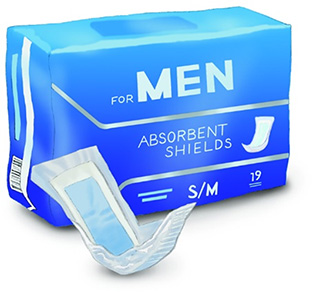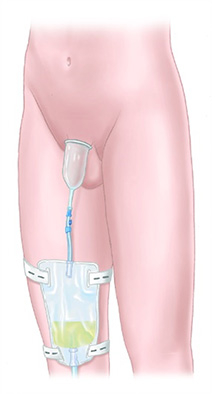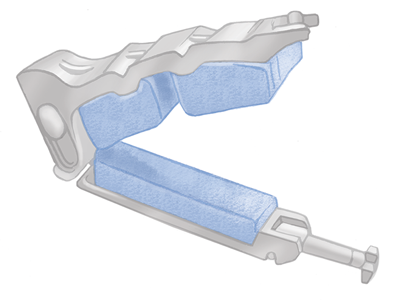Non-Surgical Treatments
There are a range of surgical and non-surgical treatment options available, like the male sling or artificial urinary sphincter designed to treat urinary leakage depending on the severity of your condition. Talk to your doctor or urologist to explore whether these options are right for you.
Behavioural Modifications
Making changes to your daily activities and lifestyle choices can help with controlling your urine leakage symptoms. Keeping a bladder diary and tracking what you eat and drink can help recognize foods that may be irritating your bladder. Thinks like coffee, alcohol, spicy foods, citrus fruits, etc. are known bladder irritants and making dietary changes may be beneficial if you are able to identify a relationship between your urinary incontinence episodes and your intake.2 It may also be helpful to manage your fluid intake as recommended by your doctor.
Pelvic Floor Exercises/Biofeedback
Your doctor may encourage you to perform regular pelvic floor/Kegel exercises to help control urine leakage. These exercises isolate and strengthen the pelvic floor muscles and can help men regain their bladder control following prostate surgery.3 It is important to do the exercises correctly and regularly. It may help to work with a nurse or physiotherapist on the exercises to ensure you are doing them properly and often enough.
Sometimes, it is difficult to tell which muscles we should be using to help control our bladder. Many patients commonly use their abdominal muscles instead of the pelvic floor muscles. Biofeedback helps patients identify which muscles are being used ensuring that you are engaging the right pelvic muscles to strengthen them and gain better control.4
Absorbent Products
Incontinence pads are commonly used to help absorb urine leakage, protect the skin and block odour. Other absorbent products include nappies and undergarments. These products can offer odour control; some are disposed after a single use, and others may be cleaned and reused.
Benefits:5
- Appropriate for every activity
- Comfortable when dry
- Good for overnight use
- Easy to use
Risks and Side Effects:5
External Collection Devices
A condom catheter, or penis pouch, is a pouch is urine collection device that looks like a condom with a hole in the end of it so urine can flow into a drainage bag. The condom catheter is placed on the penis and connected to a urine collection bag that is strapped to the body underneath clothing during the day and may rest bedside at night. Condom catheters should be changed daily to maintain good hygiene.6
Benefits:5
- Discreet option for long periods of time
- Keeps skin dry
- May help avoid odour
- Convenient for storage and travel
Risks and Side Effects:5
- May not remain in place, resulting in leaks
- Possible reactions to device materials
- Skin injuries and/or inflammation
Penile Clamps
A penile clamp is designed to help men who have light to moderate urinary leakage.6 It uses a hinged, rigid frame that supports two pads and a locking mechanism; or may wrap around the penis to keep the urethra closed. It controls leakage by applying constant pressure upon the penis to stop the flow of urine.
Benefits:5
- Secure way to stop leaking
- Easy to apply and remove
- Can be washed and reused
Risks and Side Effects:5
- Can only be worn for short periods of time
- Requires repositioning if being used over two hours
- Must be removed while sleeping
Treatment options also include injection therapy and potentially to long-term surgical options like the male sling or artificial urinary sphincter.
Find a Specialist
Talk to a urologist about treatment options. Download a referral letter or contact a urologist near you.
Partner Perspective
Understand the burden of incontinence from a partner or loved one’s perspective.
Get Talking
Recovery can start with a simple question. Explore helpful tips to kick-start the conversation about incontinence.
Take the Quiz
Take our quiz to identify if you are experiencing urinary incontinence symptoms and help kick-start the conversation with your doctor.
Questions to Ask
Helpful hints on how to start the conversation with your GP or urologist, and other useful resources.
References
- Chung, E., Katz, D. J., & Love, C. (2017). Adult male stress and urge urinary incontinence – A review of pathophysiology and treatment strategies for voiding dysfunction in men. Australian Family Physician, 46(9), 661–666.
- National Association for Continence. (n.d.). Retrieved December 13, 2019, from https://www.nafc.org/diet-and-exercise
- Pedriali FR, Gomes CS, Soares L, et al. Is pilates as effective as conventional pelvic floor muscle exercises in the conservative treatment of post-prostatectomy urinary incontinence? A randomised controlled trial. Neurourol Urodyn. 2016 Jun;35(5):615-21
- National Association for Continence. (n.d.). Retrieved December 13, 2019, from https://www.nafc.org/biofeedback
- Macaulay M, Broadbridge J, Gage H, et al. A trial of devices for urinary incontinence after treatment for prostate cancer. BJU Int. 2015 Sep;116(3):432-42.
- National Association for Continence. (n.d.). Retrieved December 13, 2019, from https://www.nafc.org/male-products.
Results from case studies are not necessarily predictive of results in other cases. Results in other cases may vary. All images are the property of Boston Scientific. All trademarks are the property of their respective owners.
Disclaimer: Individual symptoms, situations, circumstances and results may vary. This information is not intended to be used for medical diagnosis or treatment or as a substitute for professional medical advice. Please consult your doctor or qualified healthcare provider regarding your condition and appropriate medical treatment.
These Videos are meant for informational purposes only and may not be indicative of clinical outcome. The opinions, procedures and patient care policies expressed or depicted in the videos are those of the physician or practice nurse and do not necessarily reflect the opinions, policies or recommendations of Boston Scientific Corporation or any of its employees.
This site is intended for Australian residents only. Please review the Boston Scientific Privacy Policy, for practices on the collection, storage, use and disclosure of your personal information.
CAUTION : Indications, contraindications, warnings and instructions for use can be found in the product labelling supplied with each device.








